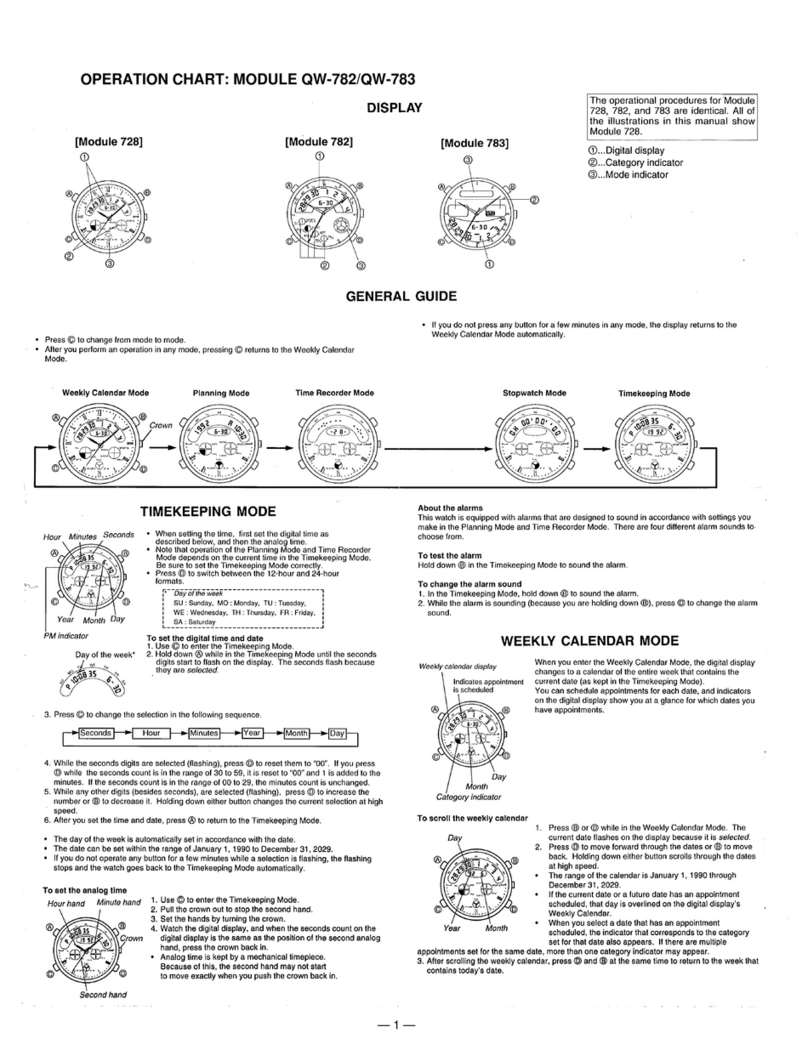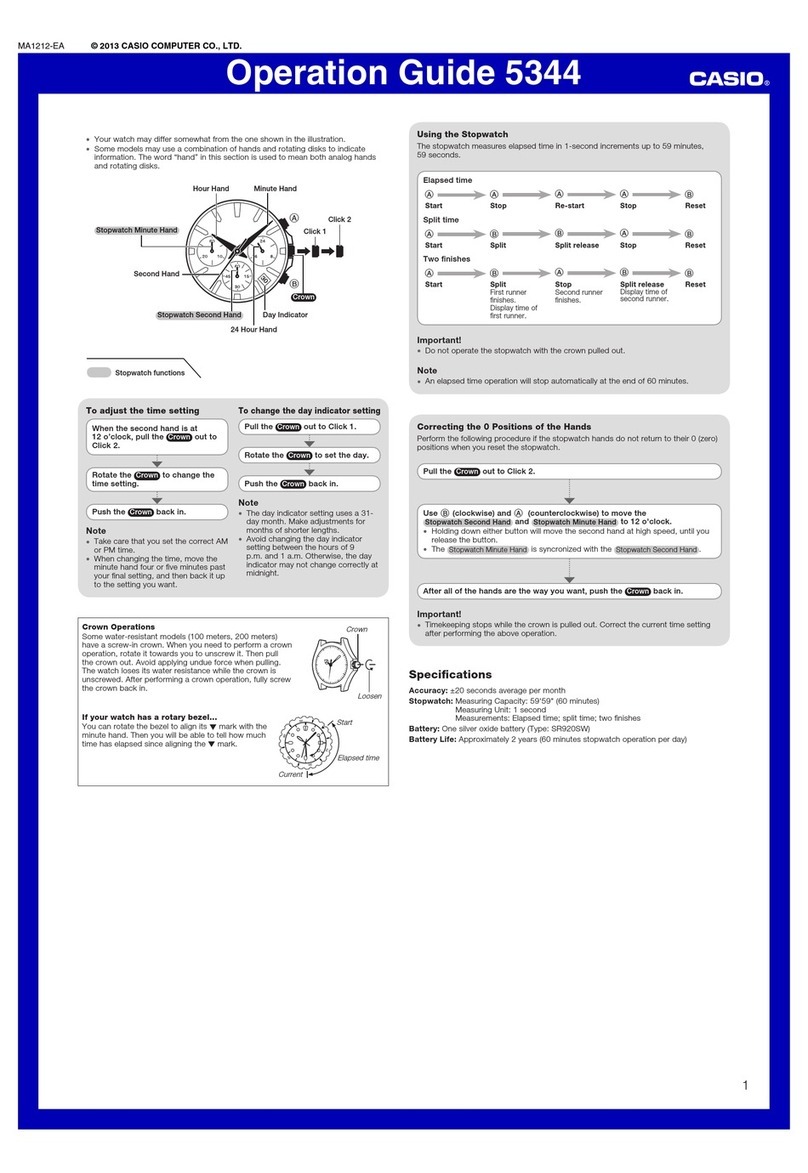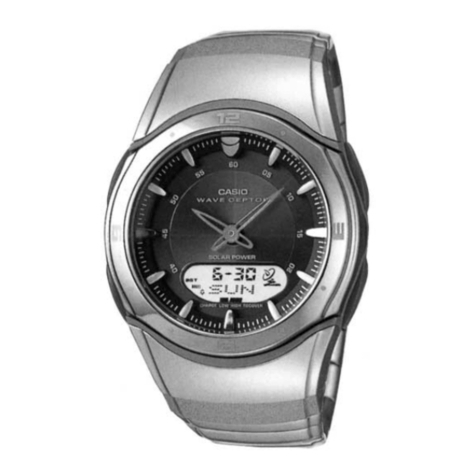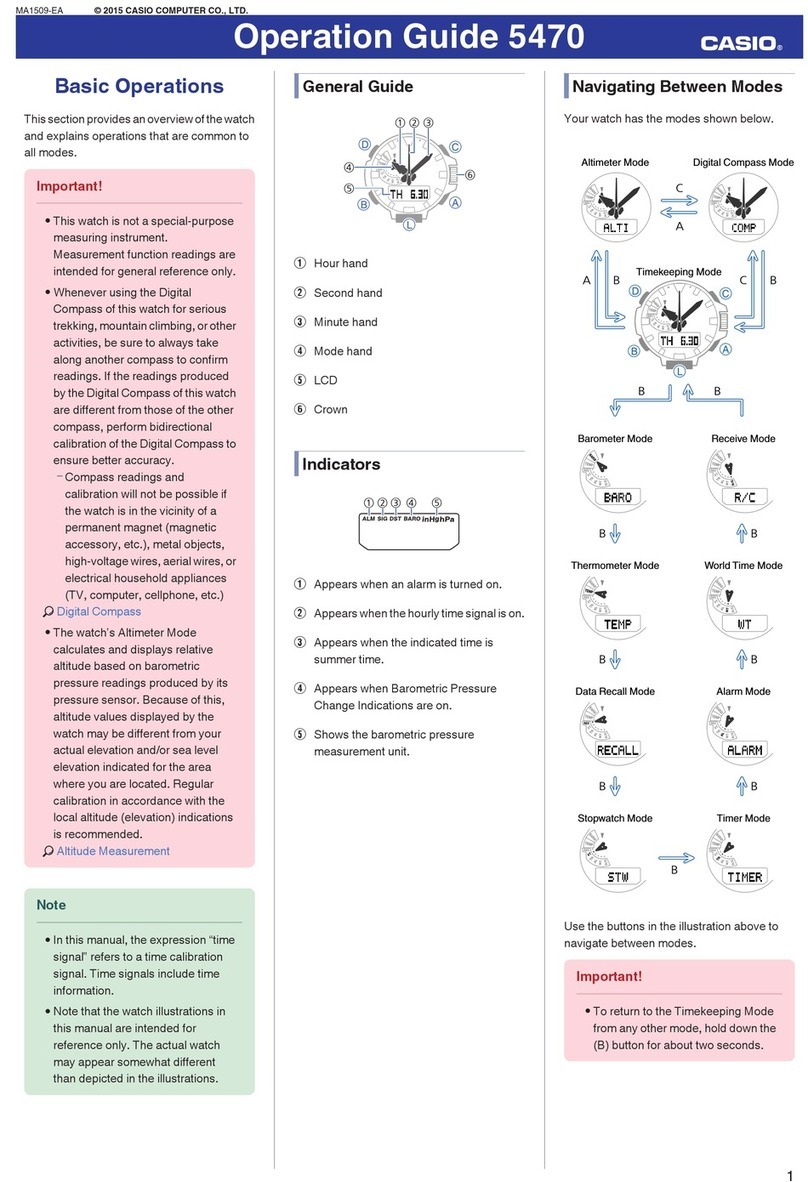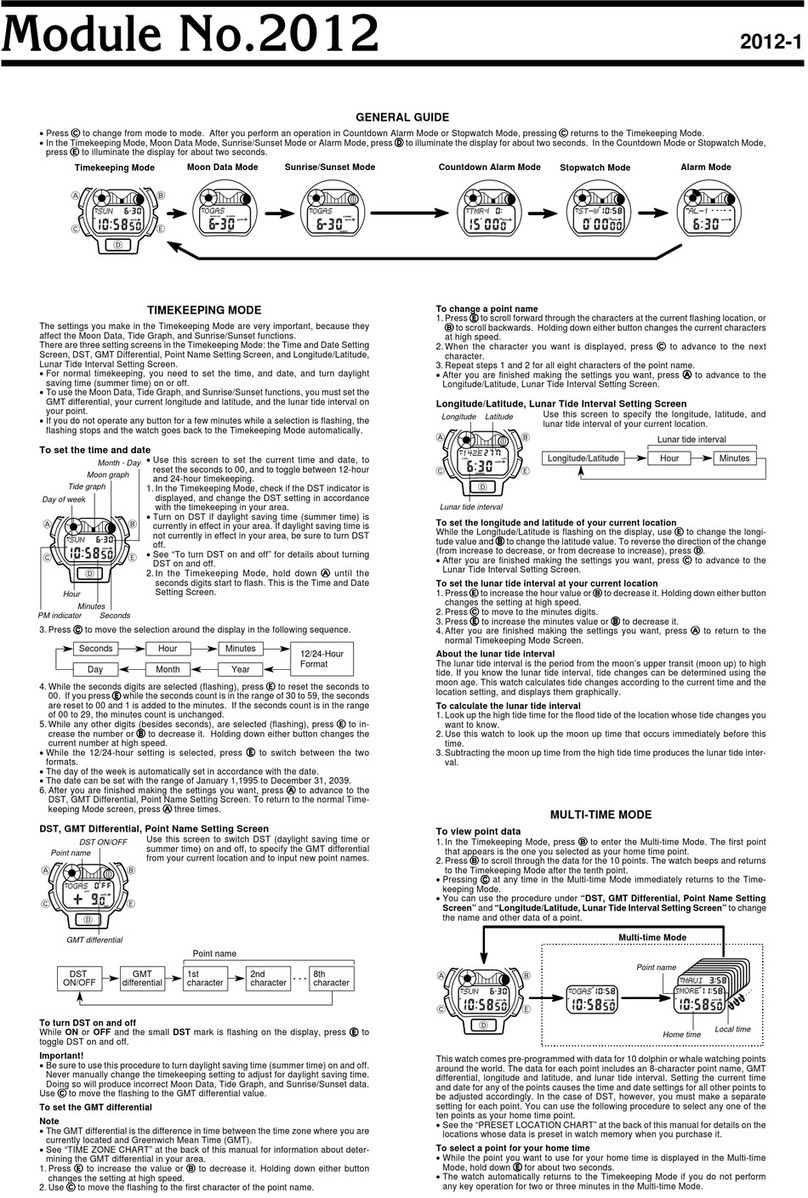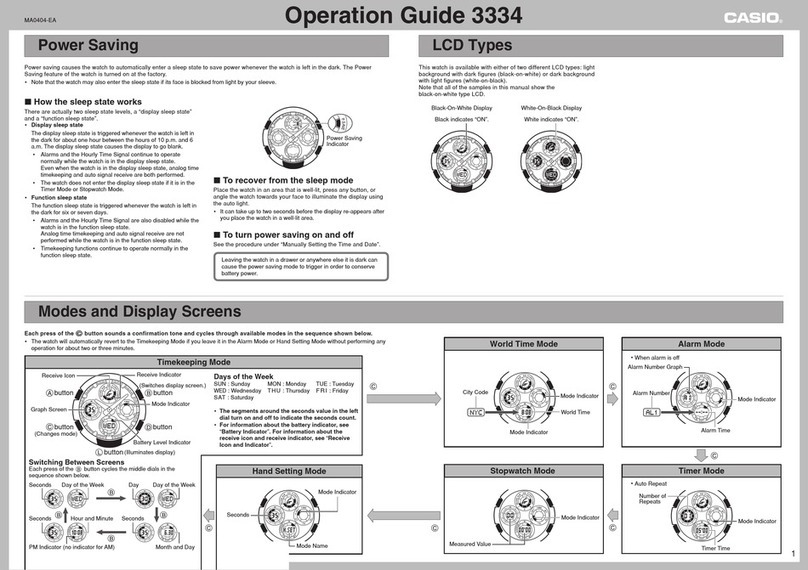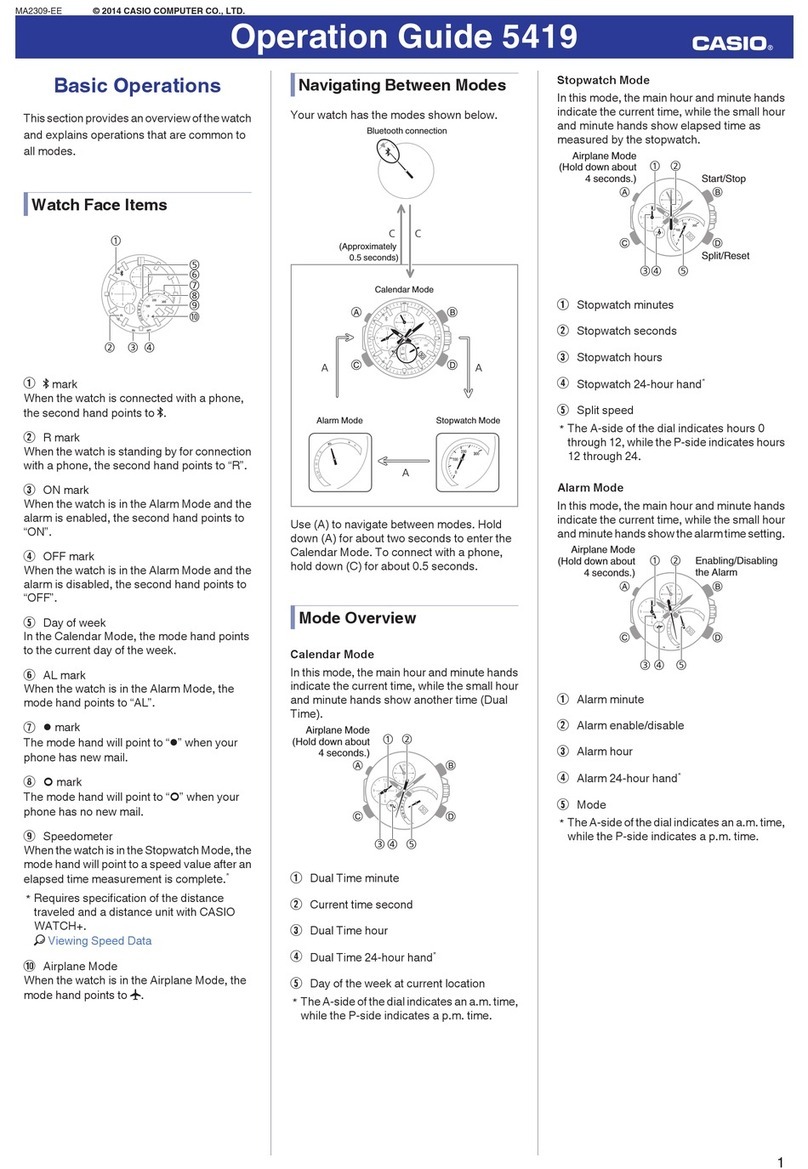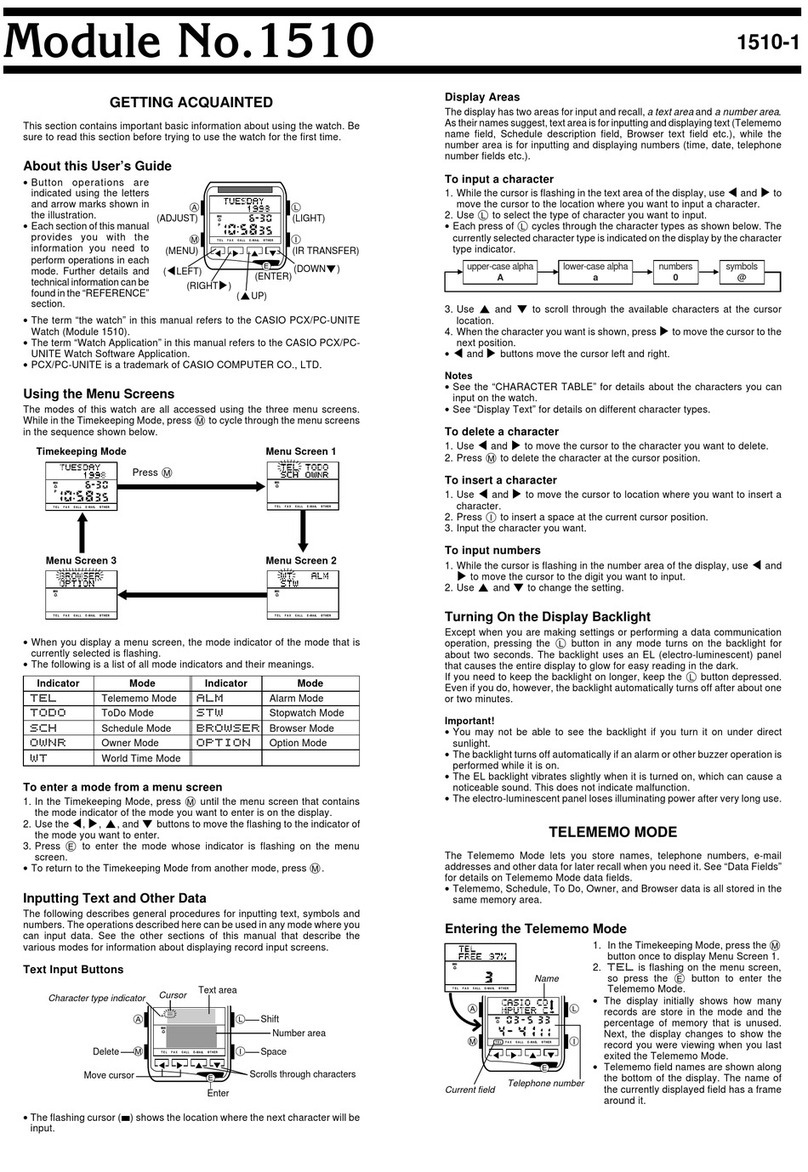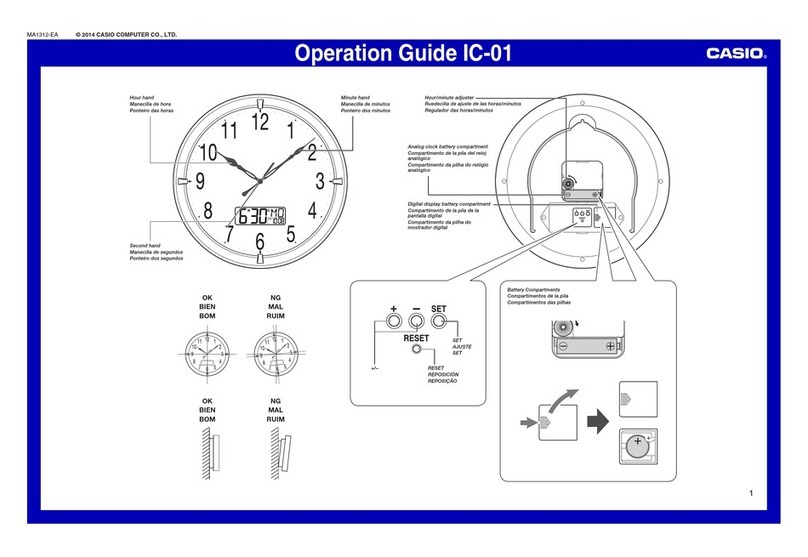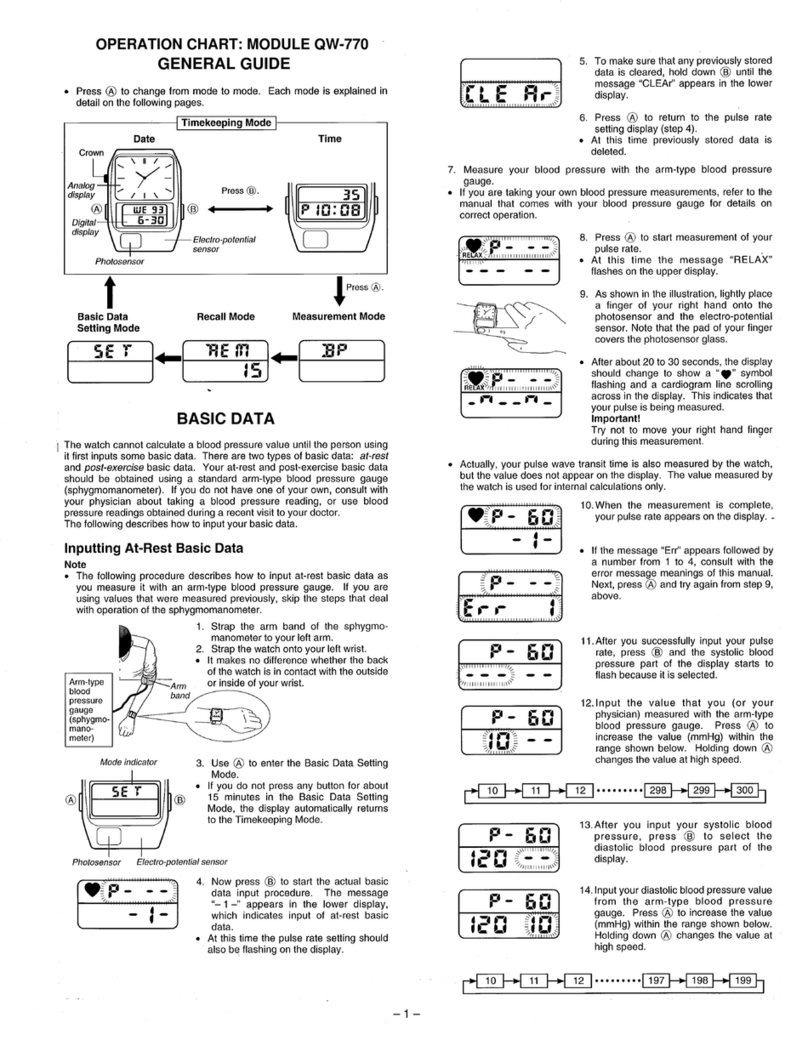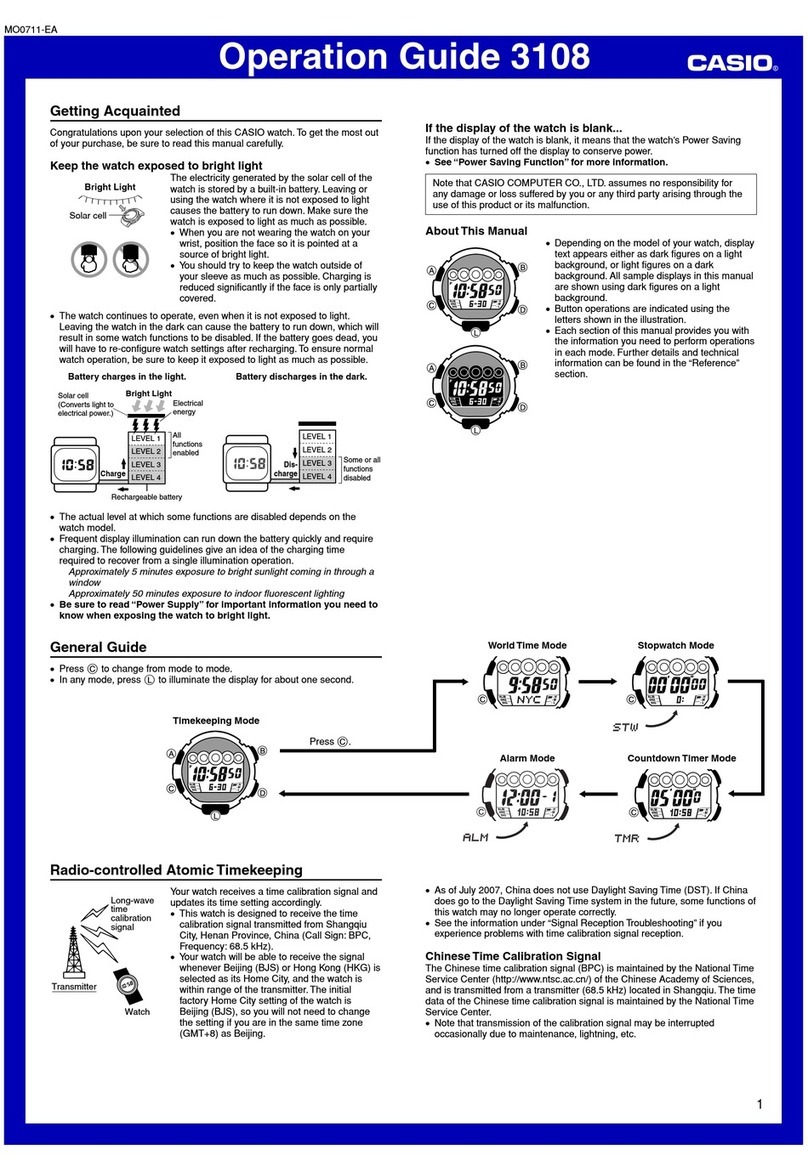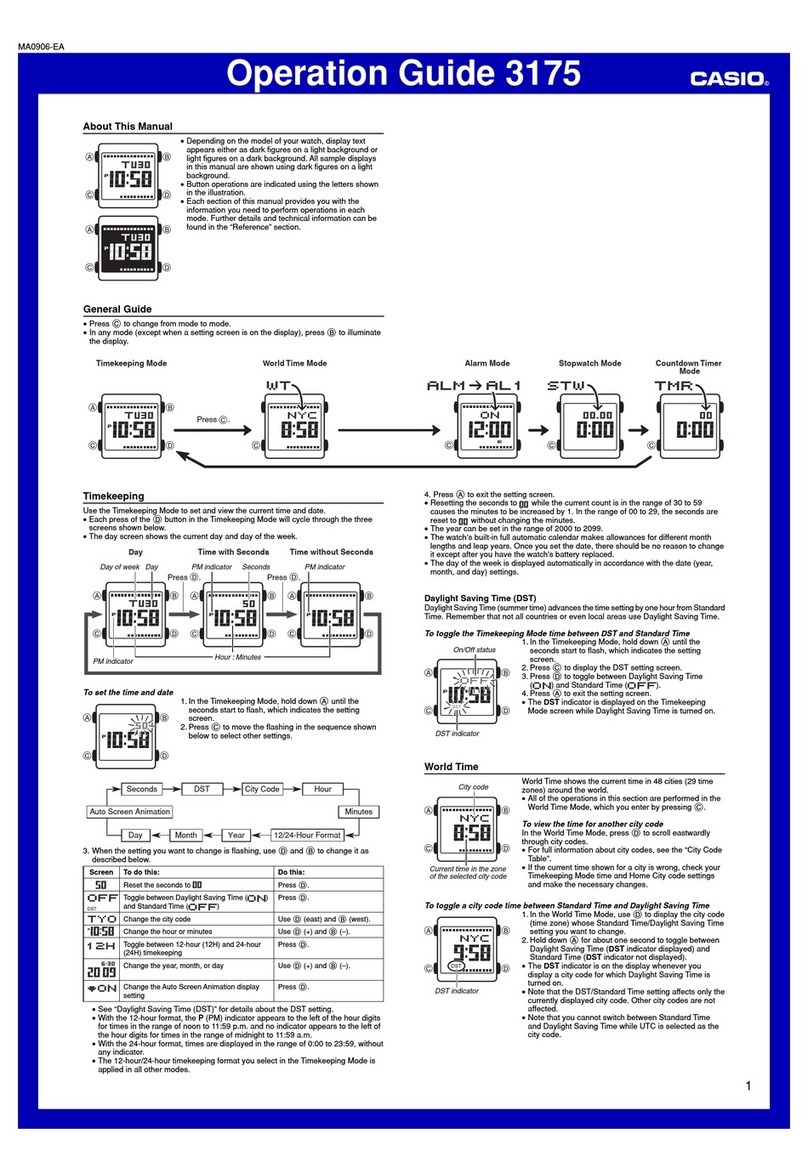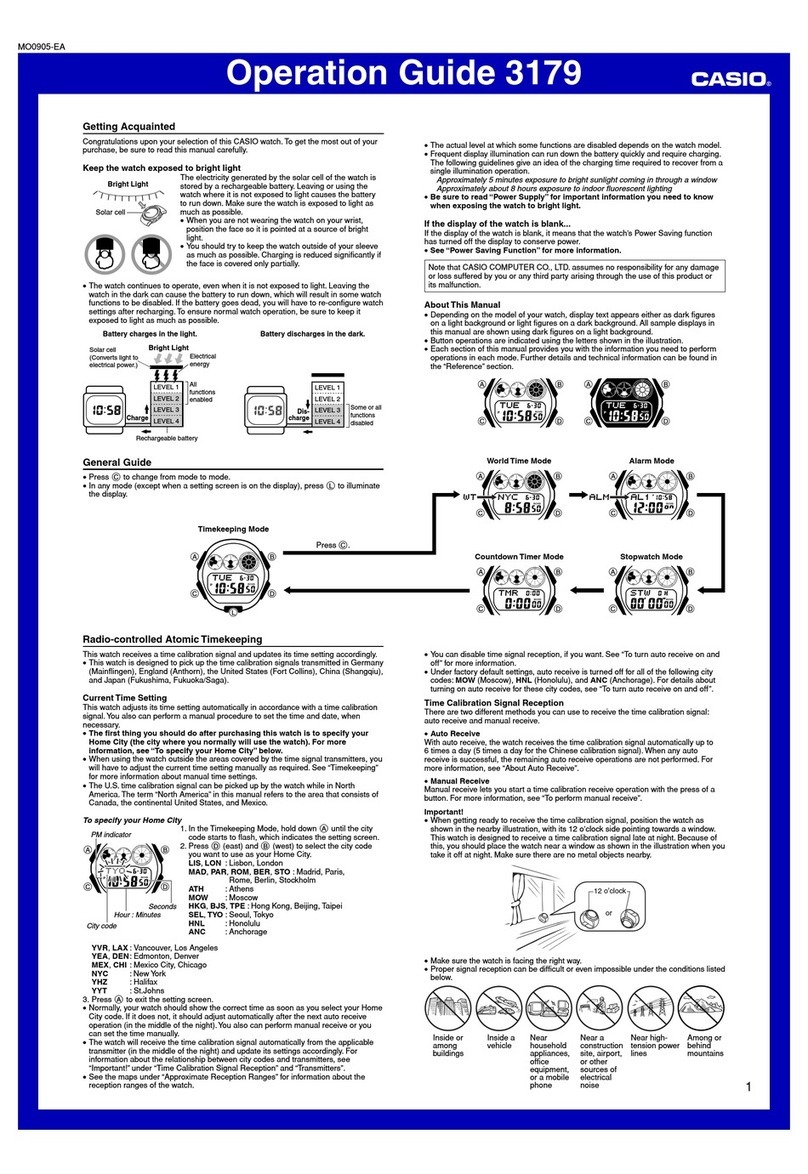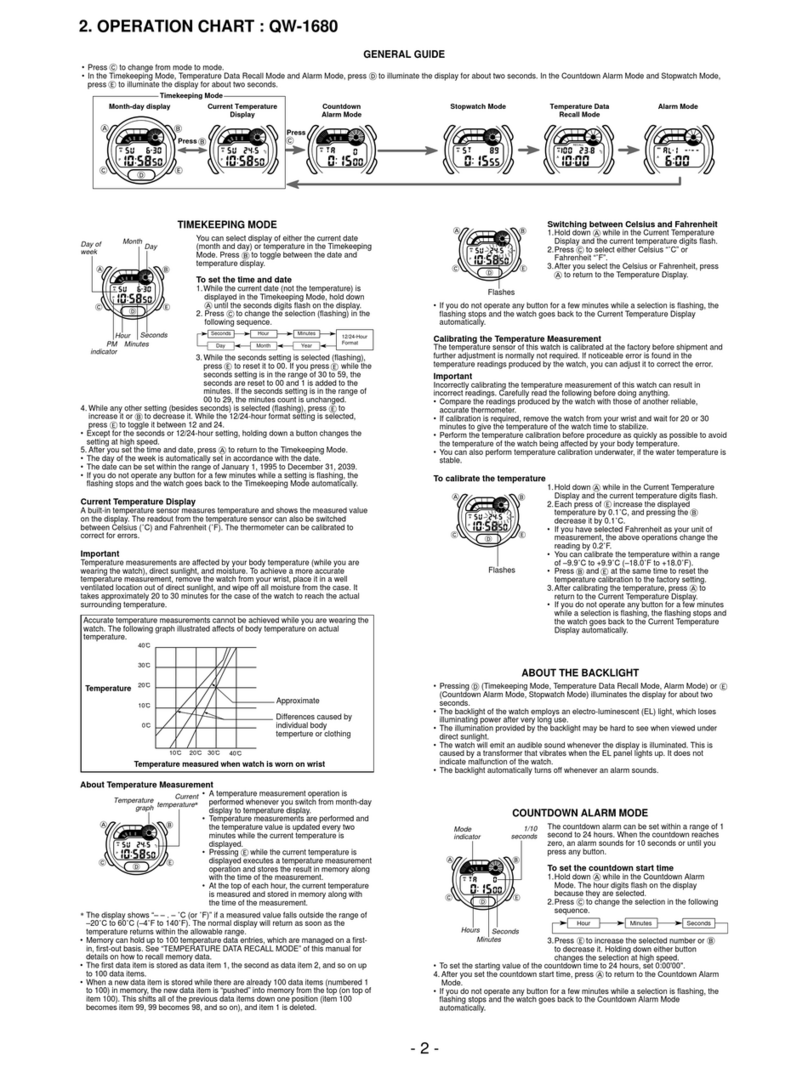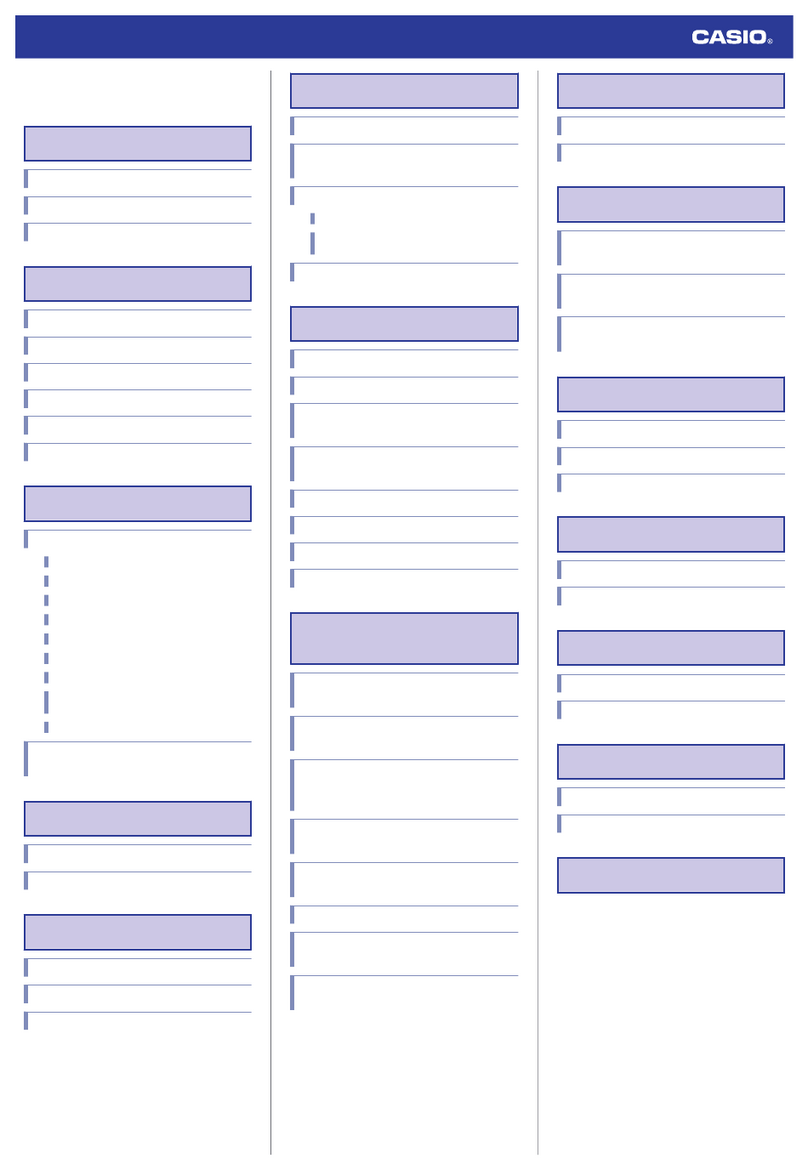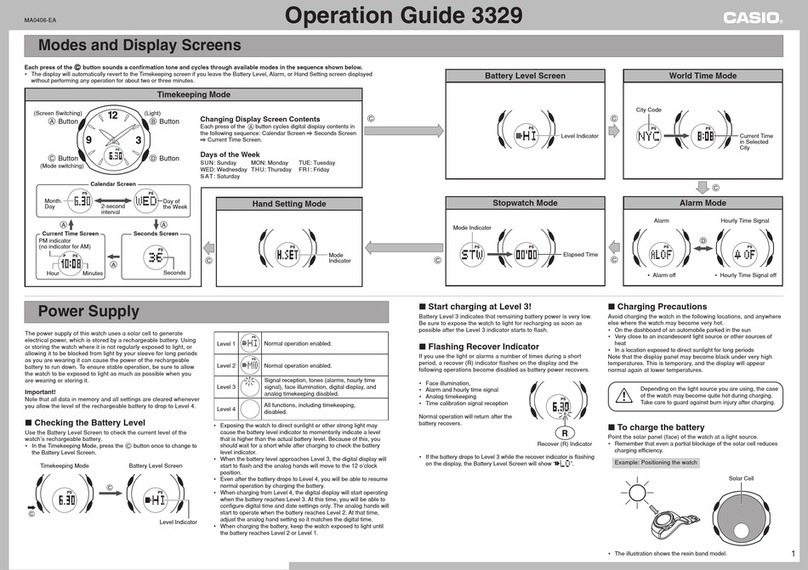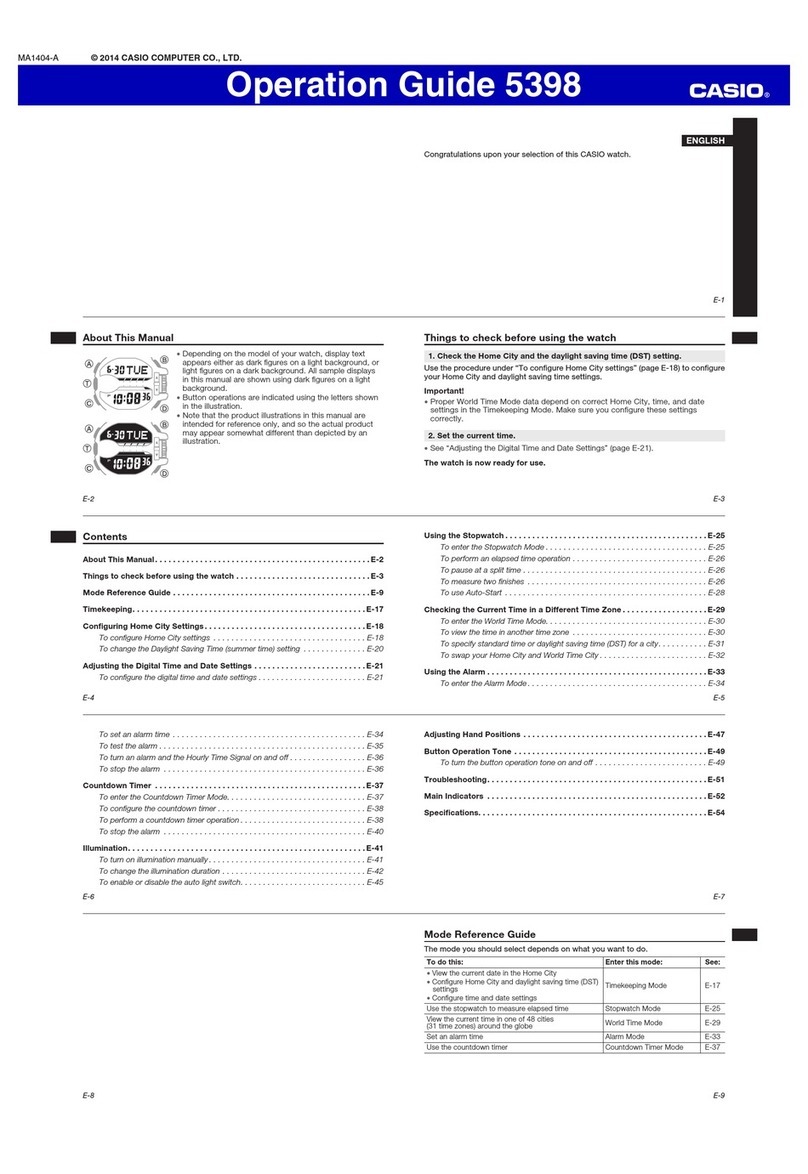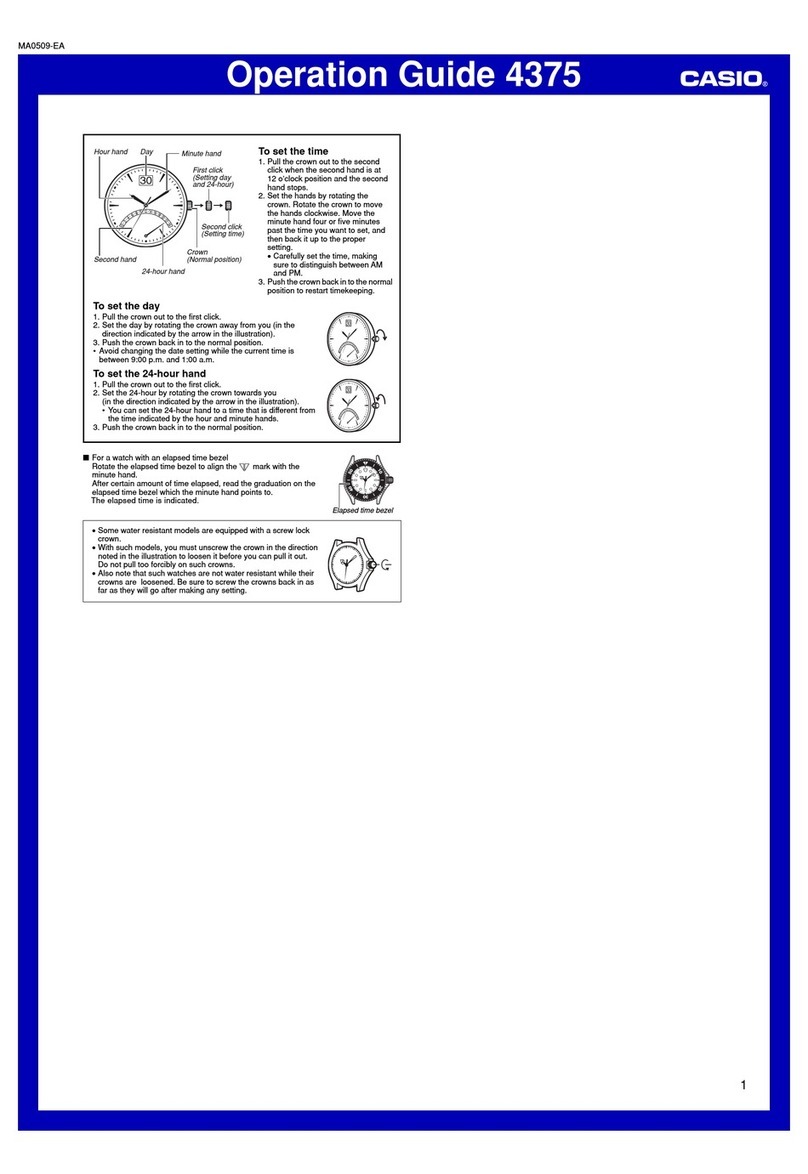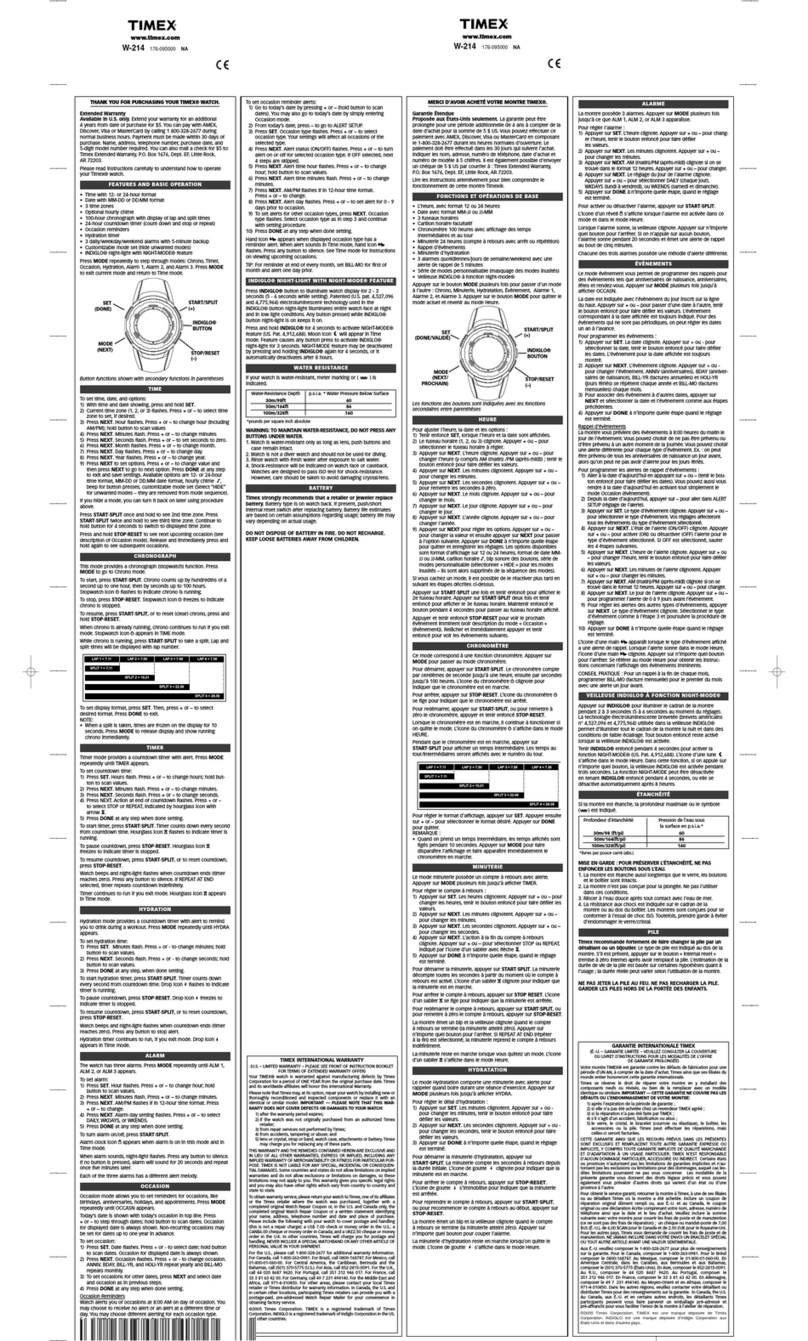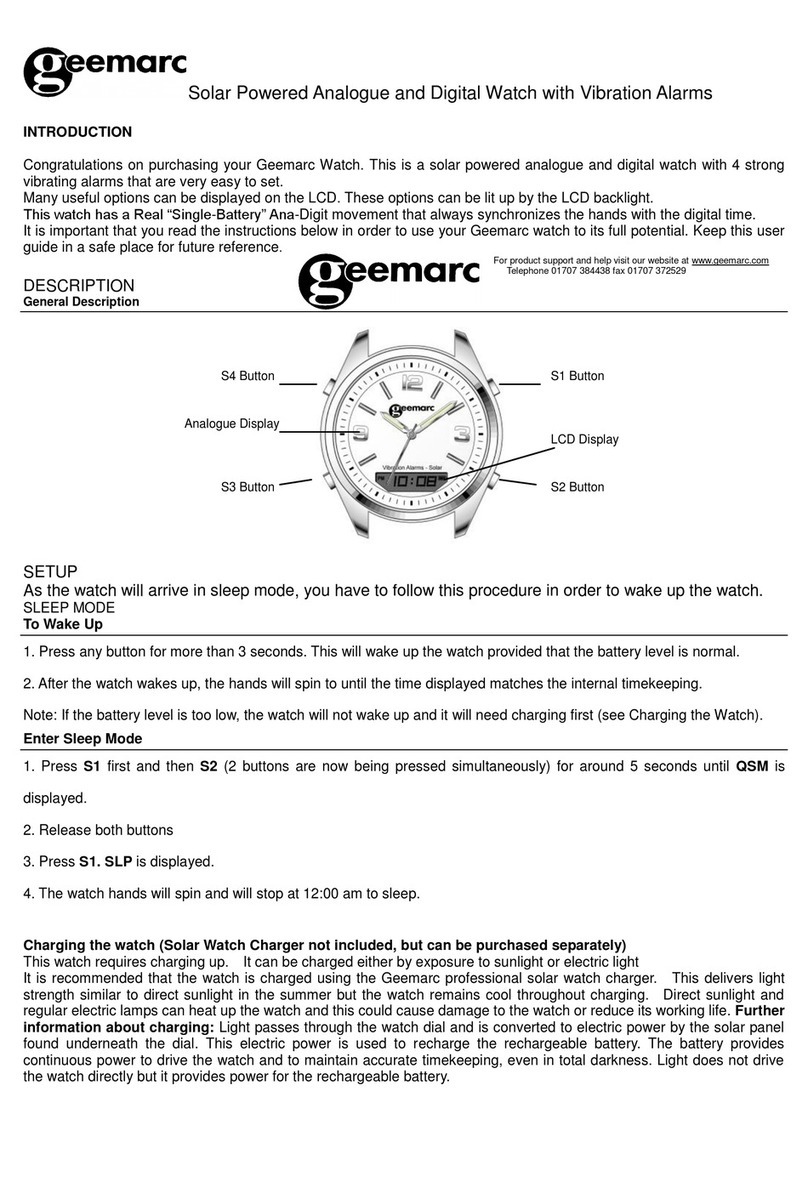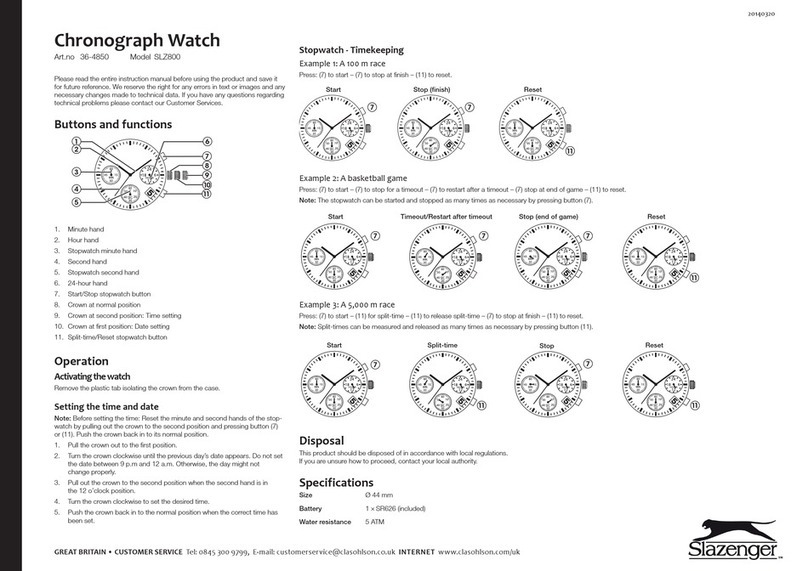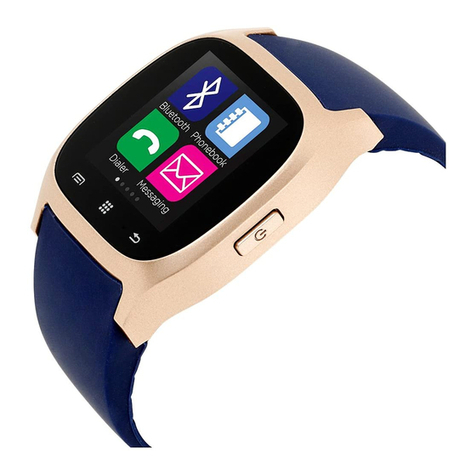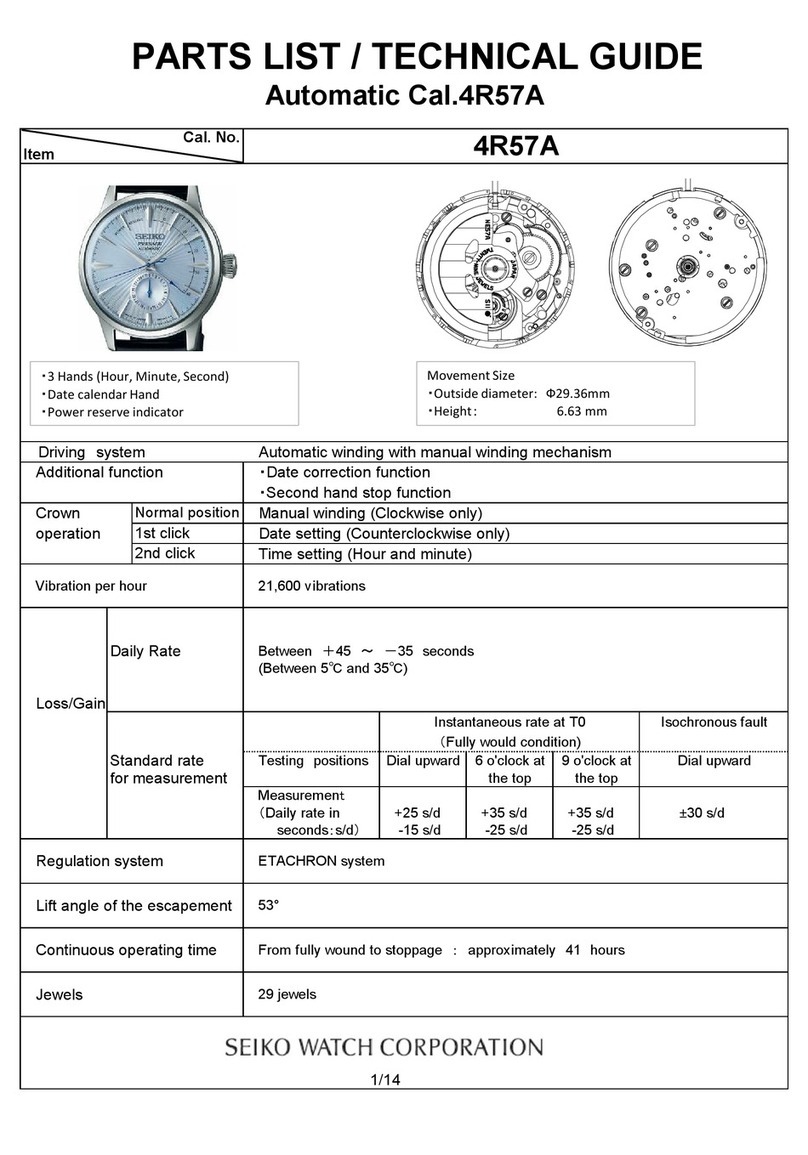
Operation Guide 3770 3771 4308 4309
2
•Signal reception is normally better at night than during the day.
•Time calibration signal reception takes from two to seven minutes, but in some
cases it can take as long as 14 minutes. Take care that you do not perform any
button operations or move the watch during this time.
•This watch is designed to receive the time calibration signal transmitted from Rugby,
England and the signal from Mainflingen, Germany. Signal reception is possible
within the area represented by a circle with a radius of about 1,500 kilometers.
•At distances further than about 500 kilometers from a transmitter, signal reception
may not be possible during certain times of year or times of day. Radio interference
may also cause problems with reception.
•See the information under “Signal Reception Troubleshooting” if you experience
problems with time calibration signal reception.
Rugby
Mainflingen
1,500 kilometers
500 kilometers
About Auto Receive
With auto receive, the watch receives the time calibration signal automatically five or
six times a day. When any auto receive is successful, the remaining auto receive
operations are not performed. The reception schedule (calibration times) depends on
your currently selected Home City Code, and whether standard time or Daylight
Saving Time is selected for your Home City Code.
Your City Code Auto Receive Start Times
1234 5 6
LIS, LON Standard Time
1:00 am 2:00 am 3:00 am 4:00 am 5:00 am Midnight
(GMT +0) Daylight Saving
2:00 am 3:00 am 4:00 am 5:00 am Midnight 1:00 am
Time
next day
Standard Time
2:00 am 3:00 am 4:00 am 5:00 am Midnight 1:00 am
next day
Daylight Saving
3:00 am 4:00 am 5:00 am
Midnight
1:00 am 2:00 am
Time
next day next day
ATH St andard Time
3:00 am 4:00 am 5:00 am
Midnight
1:00 am 2:00 am
(GMT +2)
next day next day
Daylight Saving
4:00 am 5:00 am
Midnight
1:00 am 2:00 am 3:00 am
Time
next day next day next day
BCN, MAD,
PAR, MIL,
ROM, BER,
STO
(GMT +1)
Note
•Auto receive is performed only if the watch is in the Timekeeping Mode or World
Time Mode when one of the calibration times is reached. It is not performed if a
calibration time is reached while an alarm is sounding, or while you are configuring
settings (while settings are flashing on the display).
•Auto receipt of the calibration signal is designed to be performed early in the
morning, while you sleep (provided that the Timekeeping Mode time is set correctly).
Before going to bed for the night, remove the watch from your wrist, and put it in a
location where it can easily receive the signal.
•When auto receive is turned on, the watch receives the calibration signal for two to
seven minutes everyday when the time in the Timekeeping Mode reaches each of
the five calibration times. Do not perform any button operation within seven minutes
before or after any of the five calibration times. Doing so can interfere with correct
calibration.
•Remember that reception of the calibration signal depends on the time kept in the
digital display. Reception will be performed whenever the display shows one of the
five calibration times, regardless of whether or not the displayed time is actually the
correct time.
•Calibration signal reception is disabled while a countdown timer operation is in
progress.
About the Receiving Indicator
The receiving indicator shows the strength of the calibration signal being received. For
best reception, be sure to keep the watch in a location where signal strength is
strongest.
Receiving
indicator
Weak Strong
(Level 0) (Level 3)
Modules 3770 and 4308
Receiving
indicator
Weak Strong
(Level 0) (Level 3)
Modules 3771 and 4309
•Even in an area where signal strength is strong, it takes about 10 seconds for signal
reception to stabilize enough for the receiving indicator to indicate signal strength.
•Use the receiving indicator as a guide for checking signal strength and for finding the
best location for the watch during signal reception.
•The Level 3 receiving indicator remains on the display in all modes following
reception of the time calibration signal and calibration of the watch’s time setting.
The Level 3 receiving indicator is not displayed if signal reception was unsuccessful
or after manual adjustment of the current time setting.
•The Level 3 receiving indicator indicates that at least one of the six calibration signal
receive operations was successful. Note, however, that the indicator is cleared from
the display at the next successful reception each day.
To perform manual receive
1. Place the watch on a stable surface so its top (12
o’clock side) is facing towards a window.
2. In the Timekeeping Mode, hold down Dfor about two
seconds until the watch beeps.
3. After you release Dthe display will show the current
time and the letters RC!. This indicates that signal
reception is in progress.
•Time calibration signal reception normally takes from
two to seven minutes. Take care that you do not perform
any button operations or move the watch during this
time.
•After signal reception is complete, the display of the
watch changes to the last signal screen.
Note
•To interrupt a reception and return to the Timekeeping Mode, press D.
•If reception is unsuccessful, the message ERR appears on the display for one or
two minutes. After that, the watch returns to the Timekeeping Mode.
•Yo u can also change from the last signal or ERR screen to the normal timekeeping
screen by pressing D.
•Calibration signal reception is disabled while a countdown timer operation is in
progress.
To turn auto receive on and off
1. In the Timekeeping Mode, press Dto display the last
signal screen.
•
The watch will automatically return to the Timekeeping
Mode if you do not perform any button operation for one
or two minutes after displaying the last signal screen.
2. Hold down Auntil the current auto receive setting
flashes on the display. This is the setting screen.
•If the auto receive setting does not appear when you
hold down A, it means that the city code currently
selected for the Home City is for an area that does not
support calibration signal reception. You cannot turn
auto receive on or off in this case.
3.
Use
D
to turn auto receive on
(ON)
or off
(OFF).
4. Press Ato exit the setting screen.
•To return to the Timekeeping Mode from the last signal screen, press D.
•For information about city codes that support signal reception, see “To set your
Home City”.
On/Off status
Problem
Cannot perform
manual receive.
Auto receive is
turned on, but
the Level 3
receiving
indicator does
not appear on
the display.
Probable Cause
•The watch is not in the Timekeeping
Mode.
•Your current Home City is not one of the
following city codes: LIS, LON,
BCN, MAD, PAR, MIL, ROM,
BER, STO, or ATH.
•A countdown timer operation is in
progress.
•You changed the time setting manually.
•You were performing some button
operation during the auto receive.
•Even if reception is successful, the
Level 3 receiving indicator disappears at
the next successful reception each day.
What you should do
•Enter the Timekeeping Mode
and try again.
•Select LIS, LON, BCN,
MAD, PAR, MIL, ROM,
BER, STO, or ATH as your
Home City.
•Stop the countdown timer
operation.
•Perform manual receive or
wait until the next auto signal
receive is performed.
•Check to make sure the
watch is in a location where it
can receive the signal.
Signal Reception Troubleshooting
Check the following points whenever you experience problems with signal reception.
Time setting is
incorrect
following signal
reception.
•If the time is one hour off, the DST
setting may be incorrect.
•The Home City code setting is not
correct for the area where you are using
the watch.
•Change the DST setting to
Auto DST.
•Select the correct Home City
code.
•For further information, see “Important!” under “Time Calibration Signal Reception”
and “Radio-controlled Timekeeping Precautions”.
World Time
The World Time Mode digitally displays the current time in
48 cities (29 time zones) around the world.
•If the current time shown for a city is wrong, check your
Home City time settings and make the necessary
changes.
•The watch will perform a signal reception even if it is in
the World Time Mode when a calibration time is
reached. If this happens, the World Time Mode time
settings will be adjusted in accordance with the
Timekeeping Mode’s Home City time.
•All of the operations in this section are performed in the
World Time Mode, which you enter by pressing C.
Modules 3770 and 4308
Modules 3771 and 4309
City code
Current time in
selected city
Current time in
selected city City code
To view the time in another city
While in the World Time Mode, press Dto scroll through the city codes (time zones)
to the east.
•For full information on city codes, see the “City Code Table”.

